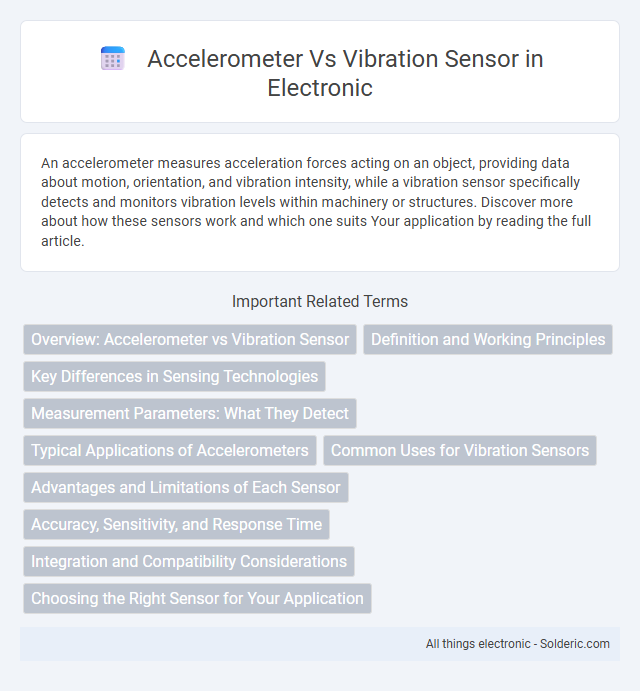An accelerometer measures acceleration forces acting on an object, providing data about motion, orientation, and vibration intensity, while a vibration sensor specifically detects and monitors vibration levels within machinery or structures. Discover more about how these sensors work and which one suits Your application by reading the full article.
Comparison Table
| Feature | Accelerometer | Vibration Sensor |
|---|---|---|
| Primary Function | Measures acceleration forces in one or more axes | Detects and measures vibration intensity and frequency |
| Measurement Type | Linear acceleration, tilt, motion | Vibration amplitude and frequency |
| Common Applications | Motion detection, orientation sensing, impact measurement | Machine condition monitoring, fault detection, structural health |
| Output Signal | Analog or digital acceleration data | Analog or digital vibration data |
| Sensitivity | High sensitivity in multiple axes (1, 2, or 3 axes) | Varies; often optimized for specific vibration frequencies |
| Typical Sensor Types | MEMS, piezoelectric, capacitive accelerometers | Piezoelectric, velocity, displacement, MEMS vibration sensors |
| Frequency Response | Up to several kHz, depending on model | Broad range; specific sensors target low to high frequency vibrations |
| Installation | Attached to object requiring acceleration measurement | Mounted on machinery or structures to monitor vibration |
| Cost | Moderate to high depending on accuracy and axes | Varies; generally moderate for industrial applications |
Overview: Accelerometer vs Vibration Sensor
An accelerometer measures acceleration forces to detect changes in velocity, including movement and orientation, while a vibration sensor specifically detects oscillatory motion or vibrations in machinery and structures. Accelerometers provide precise data on magnitude and direction of acceleration, making them suitable for applications like motion tracking and structural health monitoring. Your choice depends on whether you need detailed acceleration information or focused vibration detection for predictive maintenance and system diagnostics.
Definition and Working Principles
An accelerometer measures acceleration forces acting on it, converting these forces into electrical signals by detecting changes in capacitance, piezoelectric effect, or piezoresistive response. A vibration sensor detects oscillatory motions or mechanical vibrations and typically uses piezoelectric or capacitive methods to transform mechanical oscillations into readable electrical signals. Your choice depends on whether you need precise acceleration data or general vibration monitoring for equipment health and diagnostics.
Key Differences in Sensing Technologies
Accelerometers measure acceleration forces along one or more axes by detecting changes in velocity, making them ideal for monitoring motion and orientation. Vibration sensors specifically detect mechanical oscillations and frequency variations, typically using piezoelectric or capacitive methods to capture vibration intensity and patterns. Your choice depends on whether precise motion dynamics or vibration analysis is critical for your application.
Measurement Parameters: What They Detect
Accelerometers measure acceleration forces along multiple axes, capturing dynamic movement, tilt, and vibration frequency, which helps in analyzing motion and structural health. Vibration sensors primarily detect mechanical oscillations, focusing on amplitude and frequency of vibrations to monitor equipment condition and detect imbalances or faults. Your choice depends on whether detailed motion data or general vibration characteristics are needed for accurate measurements.
Typical Applications of Accelerometers
Accelerometers are widely used in consumer electronics for motion detection and orientation sensing in smartphones and tablets. In industrial settings, they monitor machinery health by detecting vibrations and shock impacts to prevent equipment failure. Automotive safety systems rely on accelerometers for airbag deployment and stability control, enhancing passenger protection.
Common Uses for Vibration Sensors
Vibration sensors are widely used in industrial equipment monitoring, predictive maintenance, and structural health assessments to detect abnormal vibrations and prevent machinery failures. Common applications include monitoring rotating machinery such as motors, pumps, and turbines, as well as detecting imbalances or misalignments in mechanical systems. Your ability to leverage vibration sensor data enhances equipment reliability and reduces downtime by enabling early fault detection.
Advantages and Limitations of Each Sensor
Accelerometers offer high precision in measuring acceleration, tilt, and orientation, making them ideal for dynamic motion analysis and impact detection, but they can be sensitive to external vibrations and electrical noise. Vibration sensors excel in monitoring machinery health by detecting frequency-specific oscillations and early fault conditions, though they may have limited sensitivity to minute accelerations and may require complex signal processing to interpret data accurately. Both sensors complement each other in industrial applications where accelerometers quantify motion parameters precisely, and vibration sensors provide detailed insights into equipment condition and maintenance needs.
Accuracy, Sensitivity, and Response Time
Accelerometers offer higher accuracy by measuring precise acceleration forces with multi-axis capability, making them ideal for detailed motion analysis. Vibration sensors provide greater sensitivity to specific frequency ranges, effectively detecting mechanical imbalances or faults. Your choice depends on whether you prioritize precise motion tracking or targeted vibration monitoring, with accelerometers typically offering faster response times for dynamic applications.
Integration and Compatibility Considerations
Accelerometers and vibration sensors differ significantly in integration and compatibility with your systems; accelerometers often require precise calibration and specialized interfaces for accurate motion detection, while vibration sensors typically offer plug-and-play compatibility with industrial monitoring equipment. Selecting the appropriate sensor hinges on your existing hardware and software ecosystems, ensuring seamless data acquisition and signal processing. Understanding communication protocols and power requirements further optimizes sensor performance and system interoperability.
Choosing the Right Sensor for Your Application
Selecting between an accelerometer and a vibration sensor depends on the specific requirements of your application, such as sensitivity, frequency range, and measurement type. Accelerometers excel in measuring dynamic acceleration forces, including vibrations and shocks, with high precision across a broad frequency spectrum. Vibration sensors are often optimized for monitoring specific vibration patterns and are commonly used in predictive maintenance to detect machinery faults.
accelerometer vs vibration sensor Infographic

 solderic.com
solderic.com